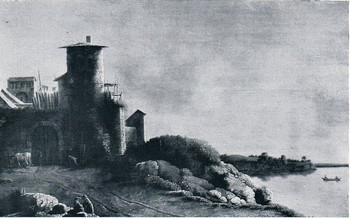Claude de Jongh
An Italianate landscape
Oil on panel : 43 X 69 cm
Signed and dated 1634
Utrecht, Centraal Museum
(black and white photograph)
This is a comparative item

Painting for Sale
Jongh, Claude de
"An Italianate river landscape"
In short
Claude de Jongh worked mainly in his native Utrecht, but also in England. It is presumed that he travelled to France (Rouen and Lyon) and to Italy (Rome). His paintings are rare and few of them are signed; ours is both signed and dated. His paintings are highly appreciated for their very personal, poetic mood.
About Claude de Jongh
Dutch painter
Utrecht circa 1600 - 1605/06 – 1663 Utrecht
Landscape painter.
Claude de Jongh belonged to a rich, old, aristocratic family of Utrecht.
He seems to have lived the major part of his life in his native town.
But he has also travelled a lot, especially to England. According to John Hayes he was already born circa 1600, for his oldest drawing, a view of the St Augustine’s Abbey outside Canterbury, dates from 1615. Our painter seems to have returned to England in 1625, 1627, 1628 and finally in 1650 to London. De Jongh was a prolific draughtsman and many of his drawings that he then made (largely of Kent and London) are now preserved in several British institutions.
During the early 1620s Claude de Jongh is said to have visited Rouen and Lyon. It is not known if he ever travelled to Italy, although he is known to have painted one topographical view of Rome, of the Isola Tibertina, dated 1634.
In 1630/31 de Jongh is documented in Haarlem. In 1634 he became Master in the Painter’s Guild of Utrecht. He is further documented here in 1636, 1638, 1643 (marrying for the second time), 1656 and finally at his death in 1663.
Paintings by de Jongh regularly bath in a beautiful, warm light. He had a very specific, unorthodox, own style: a Southern Italian light shines over rather monochrome rendered landscapes and houses. He seems to have combined the influence of the famous Italianate painter of Utrecht, Cornelis van Poelenburgh (1594/95 – 1667, returned from Italy in 1627) with the tonal technique of Jan van Goyen (1596 – 1656). Our painter favoured indeed the use of a limited colour palette, using in particular so-called earth tonalities: ochre, umber, terra di Siena, earth of Cologne and van Dijck brown.
About our painting
A very similar, or possibly the same couple as the one sitting here in the middle centre of our painting appears in a signed painting from 1646.
Why should you buy this painting?
Because this marvellous landscape breathes the atmosphere of the Provence.
Comparative paintings
Click photos for more details















